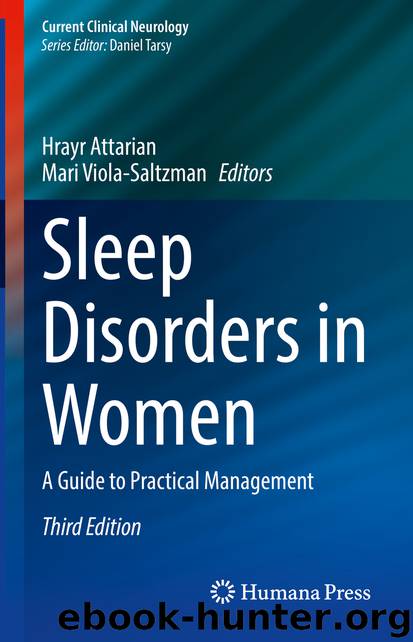Sleep Disorders in Women by Unknown

Author:Unknown
Language: eng
Format: epub
ISBN: 9783030408428
Publisher: Springer International Publishing
OSA Sequelae
OSA is associated with DM, hypertension, coronary artery disease, congestive heart failure, and stroke [7]. Other comorbid conditions include problems with daytime functioning and motor vehicle crashes [7]. Mortality from untreated OSA is estimated at 2–10%, and is attributed to vascular disease [41]. Two studies determined that Type 2 DM and insulin resistance, as measured by homeostasis model assessment, were associated with OSA in men independently of obesity [42, 43]. In the Sleep Heart Health Study, however, a cross-sectional evaluation of 470 diabetic vs 4402 non-diabetic male and female individuals showed that increases in OSA in the diabetic group were no longer evident after controlling for body habitus and BMI [44]. Although decreased serum adiponectin has been a proposed mechanism for increased cardiovascular risk among OSA sufferers, a meta-analysis of 11 studies including 240 OSA patients did not find that CPAP improved adiponectin levels, nor did BMI decrease improve pre and post CPAP [45].
Evidence for a causal influence of OSA on hypertension was supported by the prospective 8-year Wisconsin Sleep Cohort Study, in which odds ratios for hypertension increased as AHI scores worsened, even after adjusting for age, sex, body habitus, smoking, and alcohol [46]. However, nocturnal heart rate increases, hypoxemia, sleep fragmentation, and diabetes status may be better predictors of metabolic disease sequelae than AHI and merit validation for future study [47]. OSA is also an independent risk factor for coronary artery disease, according to a cross-sectional study of 6424 participants from the Sleep Health Heart Study who underwent home PSG [48]. The acute hypoxia, CO2 retention, sympathetic activation, and increases in blood pressure that occur during OSA events may all contribute to eventual coronary vascular damage [49].
There are gender-specific differences in metabolic sequelae of OSA. Men with OSA had higher area under the curve (AUC) glucose and insulin secretion rates following an oral glucose load compared to women with OSA after adjusting for confounders [50]. In a prospective cohort study in Spain, men with increasing OSA severity developed more severe hypertension, while this relationship was not observed for women [51]. A case series of 18 obese pregnant women found that 67% had mild OSA at 32–34 weeks gestation, and that AHI and oxygen desaturation index were positively correlated with AUC glucose, mean 24-h glucose, hepatic IR, fasting free fatty acids, and waking cortisol [52].
Severe OSA also contributes to left ventricular (LV) dysfunction. A prospective study of 169 patients with severe OSA but without preexisting coronary artery disease found a 7.7% prevalence of LV systolic dysfunction that normalized with CPAP treatment [53]. OSA is probably a risk factor for cerebrovascular disease, according to several prospective studies showing similarly high rates of OSA in both stroke and TIA patients compared with controls [54]. Potential mechanisms include arterial hypertension and decreased cerebral blood flow [54]. Patients with OSA also show neurocognitive impairment, which may relate to hippocampal hypoxia [55]. Cognitive dysfunction can encompass learning and memory, attention, executive function, and motor skills [41]. This may relate to the increased frequency
Download
This site does not store any files on its server. We only index and link to content provided by other sites. Please contact the content providers to delete copyright contents if any and email us, we'll remove relevant links or contents immediately.
Still Foolin’ ’Em by Billy Crystal(35547)
We're Going to Need More Wine by Gabrielle Union(18080)
Plagued by Fire by Paul Hendrickson(16641)
Molly's Game by Molly Bloom(13362)
Pimp by Iceberg Slim(12938)
Becoming by Michelle Obama(9297)
When Breath Becomes Air by Paul Kalanithi(7268)
The Girl Without a Voice by Casey Watson(7267)
Educated by Tara Westover(7070)
Note to Self by Connor Franta(7029)
The Incest Diary by Anonymous(6811)
How to Be a Bawse: A Guide to Conquering Life by Lilly Singh(6697)
The Space Between by Michelle L. Teichman(6093)
What Does This Button Do? by Bruce Dickinson(5532)
Imperfect by Sanjay Manjrekar(5415)
Permanent Record by Edward Snowden(5004)
A Year in the Merde by Stephen Clarke(4659)
Recovery by Russell Brand(4570)
Promise Me, Dad by Joe Biden(4452)
